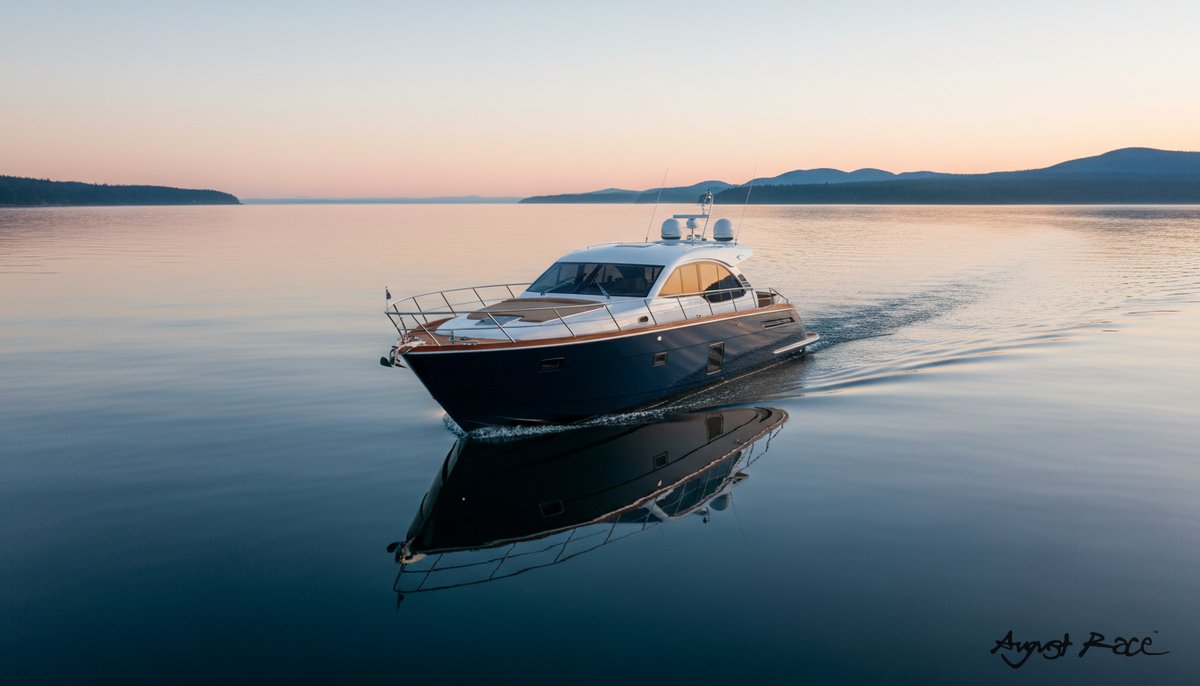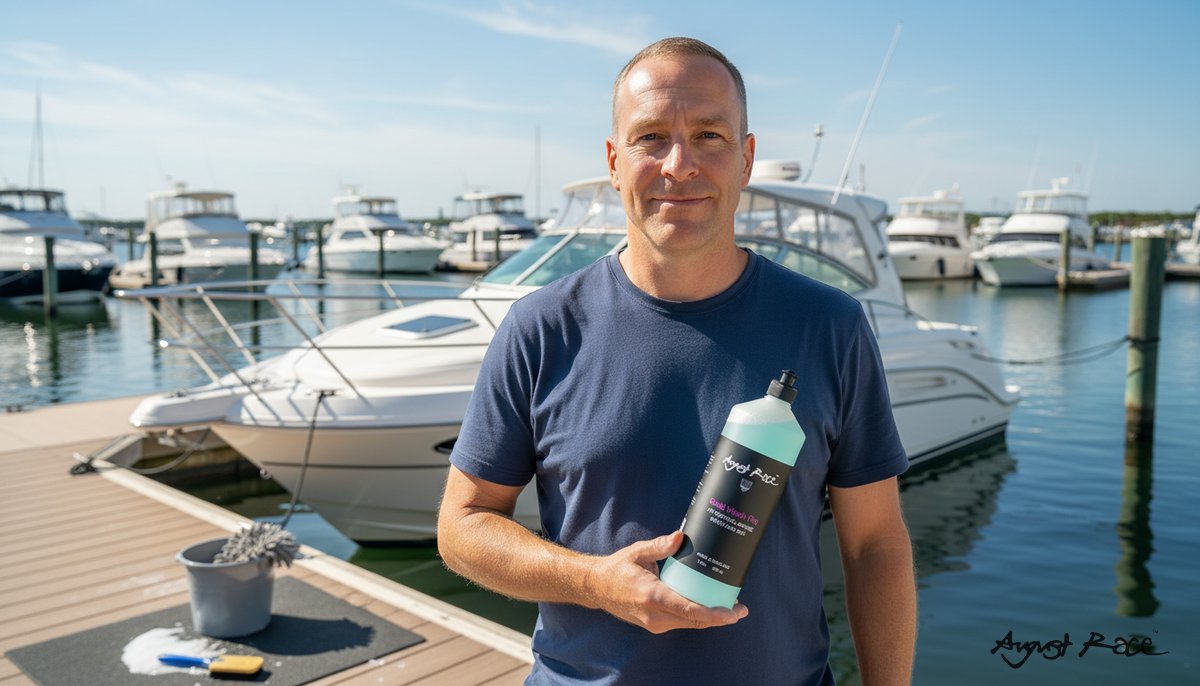Salt Removal Boat Care: How August Race Boat Wash Pro Keeps Our Berths Shipshape
Key Takeaways
- August Race Boat Wash Pro removes saltwater stains and gelcoat grime fast across fleets, cutting rinse cycles and labor hours.
- Its pH-neutral, marine-safe formula fits our eco protocols and helps reduce corrosion risk to fittings and decals.
- Scales from RIBs to visiting yachts via simple dilution controls and consistent, repeatable results.
- Slots into spring cleaning workflows, lowers follow-up detailing, and gives crews a standard post-ocean washdown.
Our marina manages a busy mix: RIBs for safety patrols, training craft that live on the dock, and visiting yachts that turn over weekly. After ocean runs, salt crust and spray leave visible saltwater stains, and repeated touch-ups stack up on our schedule. For us, “salt removal boat” isn’t a niche task -- it’s a daily operational priority tied to corrosion prevention, customer satisfaction, and berth turnaround.
Left too long, salt accelerates wear on stainless, anodized rails, and fasteners. It also dulls gelcoat, creating the kind of gelcoat grime that results in customer complaints and extra polishing. Our desired outcome is simple: quick, reliable removal of saltwater stains at scale while protecting finishes and fittings -- and doing it in a way that fits our SOPs and environmental rules.
That’s why we standardized on August Race Boat Wash Pro. It gives our teams a marine cleaning process that’s predictable across vessels and shifts, without re-training the whole dock each season.
What makes gelcoat grime different -- and why ordinary detergents fail
Gelcoat is a cured polyester or vinylester resin layer designed for gloss and protection. Unlike paint, it’s micro-porous and tends to trap oils, salt crystals, and oxidation. That’s why gelcoat grime can cling even after a high-pressure rinse.
Ordinary detergents often foam well but struggle to lift the bonded film left by spray, sunscreen, and dock dust. Crews then scrub harder, which can dull the surface or create streaks. Some harsh cleaners etch or leave residues that demand more polishing -- slowing berth turnaround and producing inconsistent results across varying crew skill levels.
Gelcoat needs targeted chemistry: surfactants that break the bond between salt and the substrate, a balanced pH to protect finishes, and rinseability that doesn’t leave a film. That’s the gap August Race Boat Wash Pro fills for us.
How August Race Boat Wash Pro works for marina-scale salt removal
August Race Boat Wash Pro combines a pH-neutral profile with marine-focused surfactants that lift salt crust and organic grime without etching gelcoat. The solution is biodegradable, which helps us maintain compliance in sensitive harbors while delivering professional results.
For throughput, we use three application modes depending on the queue:
- Low-pressure rinse and bucket wash for quick turnarounds.
- Foam cannon application when we need longer contact time on bow flare and windward sides.
- Brush-assisted wash on transoms and hand-trafficked areas where sunscreen and diesel film build up.
It’s compatible with RIB tubes, decals, plastics, and anodized hardware. The pH neutrality matters here: it helps protect seals and fittings we see across training fleets and visiting yachts.
Operationally, we’ve cut back on re-rinses and “missed patch” touch-ups. Before adopting this, crews often needed multiple rinse cycles and extra detergent to shift saltwater stains. Now, with consistent dilution and dwell times, we get a predictable finish faster and with less water per boat. Across a day of mixed vessels, that predictability is what keeps our berths moving.
SOP: Fleet-friendly step-by-step for removing salt and gelcoat grime
This is the process our dock teams follow to deliver an eco-friendly way to clean salt off boat hull at scale.
1) Pre-wash inspection (2–3 minutes)
- Walk-around: note heavy buildup zones (bow, chine, spray rails, windward side).
- Mark sensitive areas: teak, polished metals, open hatches, electronics, and non-skid.
- PPE: gloves and eye protection; non-slip footwear.
- Quick photo log for QA on first-time visiting yachts.
2) Dilution guide and equipment
- Bucket/hand pump: 1–2 capfuls per 10 L fresh water for routine washdowns.
- Foam cannon: mix per manufacturer guidance to achieve a medium foam that clings 2–4 minutes.
- Low-pressure sprayer: light dilution for wide coverage on larger hulls.
- Contact times: 1–2 minutes for light salt film; up to 4 minutes for removing grime from gelcoat after ocean use. Do not let product dry.
For RIBs and inflatables, stick to a pH neutral boat wash for RIBs like August Race Boat Wash Pro. Avoid solvent-heavy cleaners that can stress seams or fade tubes. For periodic deep cleans on tubes, use Liquid RIB cleaner.
3) Step-by-step sequence
-
Pre-rinse from top down to knock loose salt crystals and cool hot surfaces.
-
Apply wash solution (foam or bucket) to small sections. Work shaded sides first.
-
Agitate gently with a soft brush or mitt on stubborn areas (transom soot, handrails, scuppers).
-
Allow short dwell time -- keep surfaces wet; do not let product dry.
-
Low-pressure rinse thoroughly top to bottom. Check for beading and clarity.
-
Quick final inspection to prevent water spots; blade or towel glass and brightwork.
Optional: After the wash, protect cleaned gelcoat to extend gloss and make future rinses faster. Seal with GRP Sealer UV or finish with Smooth Opacity UV wax, depending on your maintenance schedule.
4) Team organization for busy marinas
- Staging: assign one bay for RIBs (high throughput) and one for 40–60 ft yachts (longer dwell/inspect).
- Parallel processing: one crew applies/agitates while another follows with rinse and QA.
- Standard timings: write target times on the job ticket (e.g., “RIB wash: 15–20 minutes”).
- Logging: record dilution, contact time, and finish score (clear, streak-free, touch-ups needed) for quality control.
5) Troubleshooting quick fixes
- Persistent salt crust: repeat application with a slightly richer dilution; extend dwell within safe window.
- Dull or etched patches: flag for follow-up polish; do not over-scrub.
- Black streaks under rub rails: agitate with soft brush and fresh solution; avoid harsh degreasers.
- If contamination is heavy (rust bloom, scale, or growth), escalate to specialist detailing per SOP.
With this SOP, new seasonal hires can achieve the same results as our senior crew -- repeatable, fast, and compliant.
Operational impact: time, cost, and presentation metrics we’ve tracked
As part of our spring cleaning tips for saltwater boats, we monitor three KPIs per vessel: minutes from first rinse to QA sign-off, number of rinse cycles, and rework calls within 48 hours. Since standardizing on August Race Boat Wash Pro, our logs show a consistent reduction in rinse-and-reapply cycles and fewer return touch-ups, especially on bow flare and windward hull sides.
On RIBs, we’ve seen faster turnaround and better gloss retention on tubes and consoles. On 40–60 ft visiting yachts, crews report clearer rinse sheets and fewer streaks -- meaning less time on final wipe-downs. Water usage per boat is down because one thorough application and a controlled dwell time now does the heavy lifting.
Environmentally, using a pH-neutral, biodegradable wash has reduced our reliance on harsh alkaline products and aligns with harbor discharge guidelines. Intangibles matter too: faster berth turnover, better first impressions on arrival days, and simpler crew training -- all of which support smoother operations.
Common objections from marina teams -- and how we resolved them
- “New product = extra training.” We built a one-hour onboarding: 10-minute chemistry brief, 20-minute live demo, 20-minute supervised practice, 10-minute QA check. Crews had a ready SOP they could follow the same shift.
- “Is it worth the cost?” Labor is our biggest line item. Cutting rinse cycles and rework saves crew hours; that covers product spend while improving finish quality.
- “Harbor discharge limits?” August Race Boat Wash Pro is pH-neutral and biodegradable. We log dilutions, dates, and vessels, and keep SDS on file to satisfy authorities.
- “What about heavy encrustation?” We use the wash for routine to moderate grime. For scale, rust bloom, or growth, we escalate to specialist detailing per our SOP to protect finishes.
Pilot checklist: rolling August Race Boat Wash Pro out across our berths
Set up a quick, low-risk pilot to validate salt removal boat performance in your facility.
- Scope: 6–8 vessels over two weeks -- mix of RIBs, mid-size cruisers, and one 50–60 ft yacht.
- Prep: dilution gear (buckets, foamers, sprayer), PPE, a 60-minute training slot, and a simple time/finish data sheet.
- Success criteria: reduced rinse cycles, measurable time savings per vessel, fewer rework calls, no regulatory flags. If met, standardize marina-wide.
- Next step: request a sample kit and on-site demo from August Race Boat Wash Pro. Or browse August Race products to outfit crews ahead of peak traffic.
Run the pilot alongside existing workflows so crews can compare like-for-like. The goal is a smoother, eco-friendly way to clean salt off boat hull and deck surfaces without disrupting schedules.
FAQ: quick answers for busy dock supervisors
To round out your plan, here are concise answers to common questions we field on the dock.
How do we use a pH neutral boat wash to remove salt from RIBs without damaging fittings?
Dilute August Race Boat Wash Pro per guidance, apply to small sections, and let it dwell briefly before a low-pressure rinse. Its pH-neutral formula helps protect tubes, decals, and anodized fittings while lifting salt and film efficiently.
Can August Race Boat Wash Pro remove heavy gelcoat grime after prolonged ocean exposure?
It is designed to tackle routine to moderate build-up, including removing grime from gelcoat after ocean use. For severe oxidation, rust bloom, or scale, escalate to polishing or specialist detailing to protect the finish.
What dilution and application methods work best for fast turnaround at a busy marina?
Use bucket or sprayer application for light salt film and a foam cannon for areas needing 2–4 minutes of contact time. Keep surfaces wet, work top-down, and standardize dwell and rinse times on the job ticket for consistent results across crews.
Is this product safe to use near sensitive harbors and compliant with discharge rules?
August Race Boat Wash Pro is pH-neutral and biodegradable, which supports compliance in regulated marinas. Maintain SDS and dilution logs and follow local discharge guidance as part of your environmental SOP.
How quickly can a marina-scale pilot prove time and cost savings?
Most marinas can validate results within 10–14 days by tracking minutes per wash, rinse cycles, and follow-up detailing. If the pilot hits your criteria, you can scale the process across berths with minimal disruption.
If you’re preparing for peak season or planning spring cleaning tips for saltwater boats, now is the time to standardize your salt removal boat process. Start a guided pilot with August Race Boat Wash Pro and give your crews a faster, cleaner, and compliant way to keep every berth shipshape.
About the Author
August Race Team
The August Race professional team brings decades of marine industry expertise and product development knowledge.
Get Expert Tips
Subscribe for marine care insights and product updates from industry professionals.
No spam. Unsubscribe anytime.
You May Also Like

Best Homemade Oxidation Remover: Quick Answer
DIY can lift light gelcoat oxidation. For deeper chalking and longer-lasting UV protection, August Race Smooth Opacity UV is the better, faster choice.

Fix Oxidized Gelcoat Fast: A Marina Manager’s Guide
Restore oxidized gelcoat fast at scale. Our marina-tested workflow plus Smooth Opacity UV adds lasting UV protection and cuts rework across multiple boats.

Can faded fiberglass be restored? | August Race
Yes, faded GRP often responds to cleaning, compounding, polishing, and a UV sealer. Learn when to restore and how GRP Sealer UV protects.
